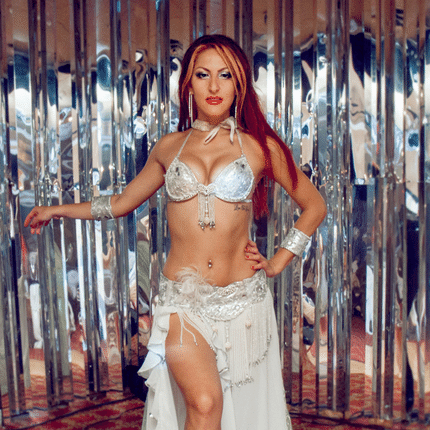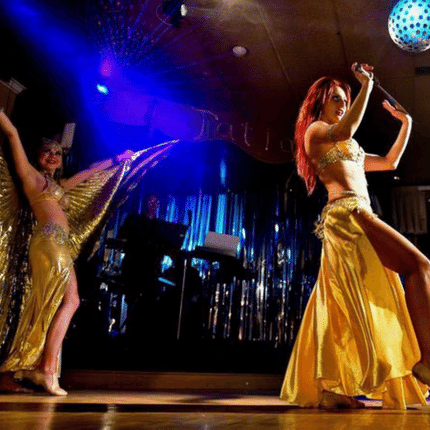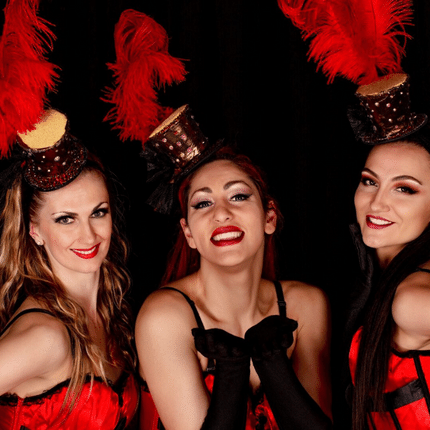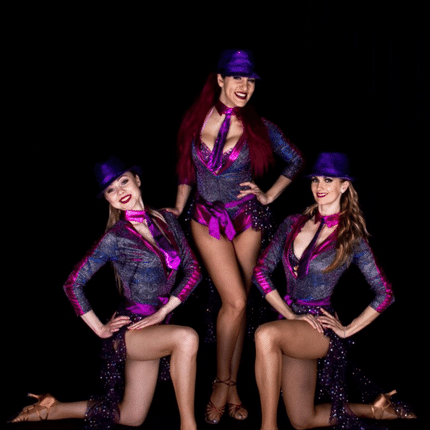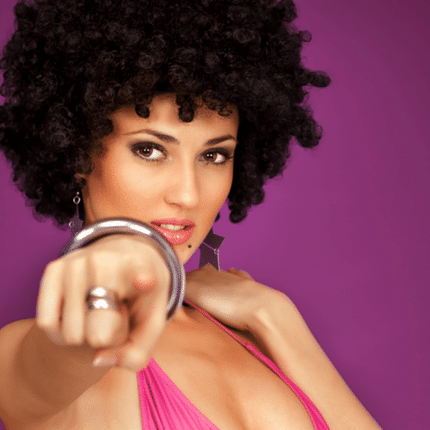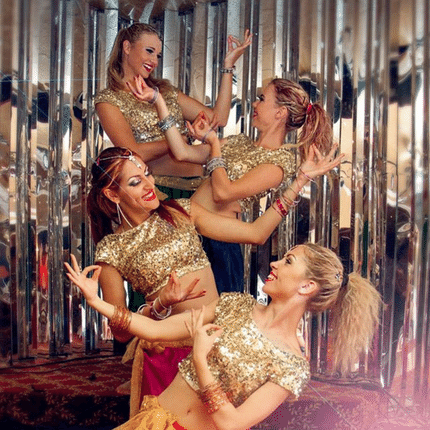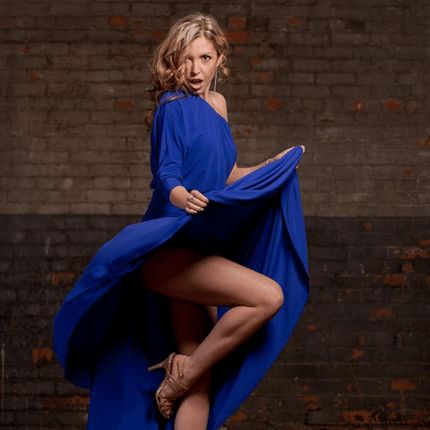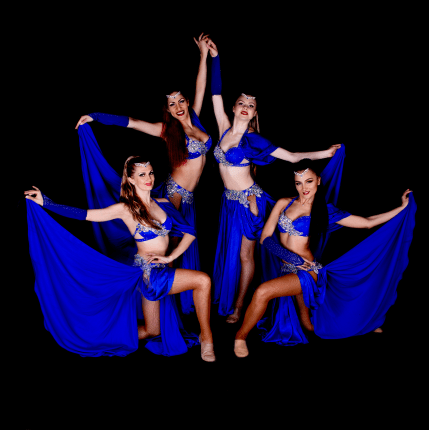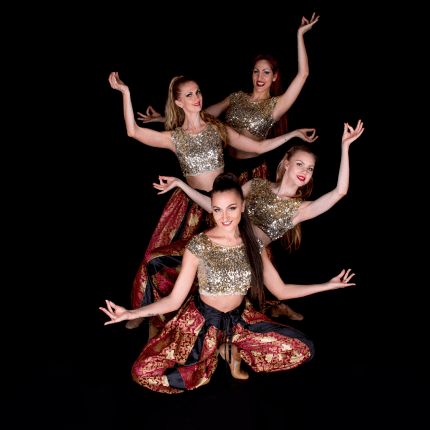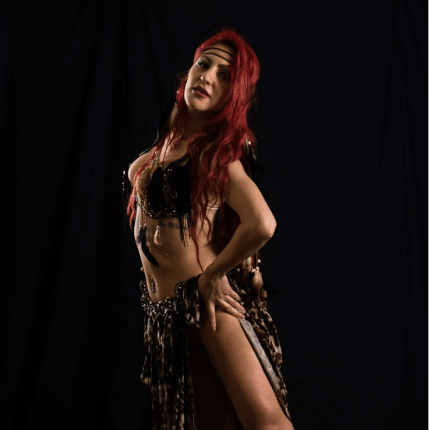Try King Dancer Pose for a Balance Challenge
Natarajasana, also known as the Dancer Pose or Lord of the Dance Pose, represents the God Shiva in his facet of God of Destruction. In the mythical cosmogony of India, Brahma, Vishnu and Shiva are the three aspects of the same divinity: Brahma as Creator, Vishnu as Preserver and Shiva as Destroyer. This asana symbolizes the terrible dance, Tandava, that Shiva will perform when he has to destroy all that is known, so that a new cosmos will arise again.
Similar to its symbolic inspiration, the Lord of the Dance Pose represents the pursuit of inner tranquility amidst turmoil. It is an elegant standing posture, of intermediate to advanced difficulty, which requires several skills to be practiced correctly and in all its majesty. This is why, even in its simplest version (the one we will mainly focus on), it can be quite intimidating.
That’s why today we will giv out some times to ease things out!
Preparing for the dancer's pose
To prepare for Natarajasana, it is important to engage in specific stretches that target the shoulders, chest, hips, and inner thighs, which are the areas that will be challenged in this pose. Incorporate exercises such as Vrksasana (Tree Pose) for balance and Gomukhasana (Cow Face Pose) for deep stretches.
During the execution of Dancer Pose, focus on standing on each leg to enhance ankle strength and address any potential muscle imbalances in the legs, hips, and glutes. For improved accessibility to Natarajasana, you can utilize a strap. This will assist in maintaining squared hips towards the front of the mat, while also keeping the lifted knee aligned with the hip instead of being positioned outwardly.
Dancer Pose Yoga Sequence Preparatory Poses
The Tree Pose (Vrksasana)
Tree Pose is a standing yoga pose that strengthens the legs and ankles, and improves overall balance. This pose helps dancers develop stability and concentration while cultivating a sense of groundedness and poise.
To practice Tree Pose:
- Start this pose with your feet firmly planted hip-width, so your weight is equally distributed, thus being balanced.
- Choose the leg you are going to hold onto the ground (the standing leg), and bend the other leg slowly, so the sole of your feet rests on the inner thigh at knee joint level. Then, point the knee of the bent leg outwards. If your standing leg is the left, then you should place the sole of your feet on the inner left thigh and vice-versa.
- Find your balance and bring your hands to your heart center in prayer position.
- Engage your standing leg, pressing it firmly into the ground.
- Lengthen your spine, draw your shoulders back, and relax your facial muscles.
- If you feel stable, you can extend your arms overhead, reaching towards the sky.
- Hold the pose for several deep breaths, feeling the strength and stability in your standing leg and the elongation of your spine.
- Slowly release the pose
The Cow Face Pose (Gomukhasana)
Cow Face Pose is a seated yoga pose that targets the hips, thighs, and shoulders, providing a deep stretch and improved mobility in these areas. This pose helps dancers enhance flexibility and release tension, particularly in the muscles surrounding the hips and shoulders.
To practice Cow Face Pose:
- Sit with legs bent and feet flat on the floor. Slide your left foot to your right hip. Cross your right leg over your left leg, also bringing your foot to your opposite hip, so that your knees are on top of each other.
- Stretch the right arm to the right and turn the palm to bend the elbow so that the forearm is parallel to the spine. Now extend the left arm forward, turn the palm and bring it toward the ceiling. Bend the elbow and bring the right hand down to engage the fingers behind your back.
- Lift the left elbow toward the ceiling and lower the right elbow toward the floor. Tend to bring the shoulder blades together and pull the sternum toward the ceiling. Head forward.
- Switch legs and arms and repeat the pose.
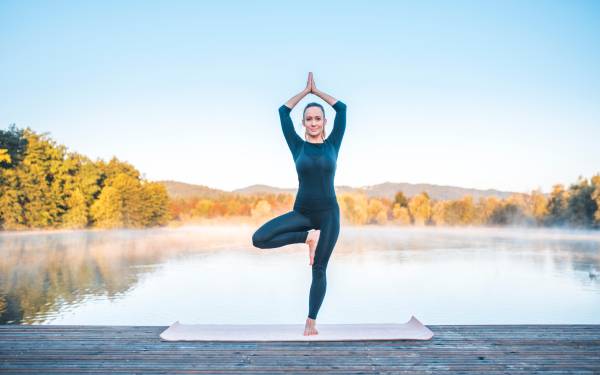
Benefits And Perks
Dancer Pose Natarajasana is a standing balance and backbend posture that primarily targets the lower body. Benefits of Dancer Pose include improved balance, enhanced focus, better posture, and increased body as well as postural awareness. It can also provide an energy boost, alleviate fatigue, and contribute to building confidence and empowerment.
Additional advantages of practicing Dancer Pose include strengthening the core and back muscles, while simultaneously stretching the chest and shoulders. This pose is also good for stretching the hips, quads, and ankles.
As for the standing leg, this pose also strengthens the thigh with a simultaneous stretch in the hamstrings, the hip, as well as the shin, and the ankle. On the lifted leg, it strengthens the hamstring and glute.
How To Do The Pose
- Start by standing in Mountain pose. Keep your hips squared and balance your weight.
- Shift your weight onto your right foot gradually.
- Extend your left leg backward, bending the knee, and bringing the left heel towards your left glute. Maintain your left knee hugging towards your midline.
- Reach your left hand towards your left foot and grasp the inner ankle.
- As you to step four, rise your right hand towards the ceiling.
- Choose a focal point to maintain your gaze and enhance balance.
- Engage your core muscles and press firmly into your grounded foot for stability.
- Begin to lean your torso forward while maintaining your chest open.
- Lift your right foot away from the ground, gradually raising your back foot as high as comfortable. Aim to align your back thigh parallel to the ground.
- Hold the pose for several breaths. To release, exit the pose slowly. Lower your back foot down and return to Mountain pose.
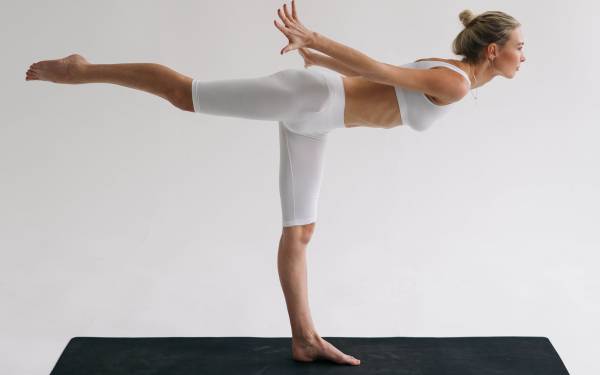
Dancer's Pose Variation: Dancer's Pose With A Strap
By using a strap in this variation of Dancer's Pose, dancers can deepen the stretch and improve their alignment while maintaining stability. To practice Dancer's Pose Variation with a strap:
- Assume the position of Mountain Pose, also known as Tadasana. Place your left hand on your left hip and transfer your body's weight to your left leg. Grasp a strap in your right hand. Proceed to bend your right leg, raising the foot behind you. Wrap the strap around the top of your right foot and bring both ends of the strap over your shoulder.
- Establish your focus on a specific point in front of you. Next, raise both elbows towards the sky, aligning your biceps with your ears, and grasp the strap ends with both hands at the base of your skull. Ensure that your upper arm bones remain pushed back. Orient your hips towards the front of the mat and initiate a strong kick into the strap, gradually moving into a backbend.
- If you possess the necessary flexibility, you can gradually advance your hands up the strap, shortening its length. Maintain firmness and engagement in the standing leg while propelling the back foot upwards towards the ceiling.
- Once in this position, sustain it for five deep breaths. Proceed to switch sides.
- Using a strap in this Dancer's Pose variation allows dancers to gradually increase the stretch in their quadriceps and hip flexors while maintaining proper alignment and stability. It also provides support for those who may have limited flexibility or are working on improving their balance. With regular practice, this variation can help dancers enhance their performance and develop greater control and grace in their movements.
Modifications and Variations
- Dancer's pose holding a chair
- Dancer's pose holding onto a wall
- Dancer's pose with overhead grip
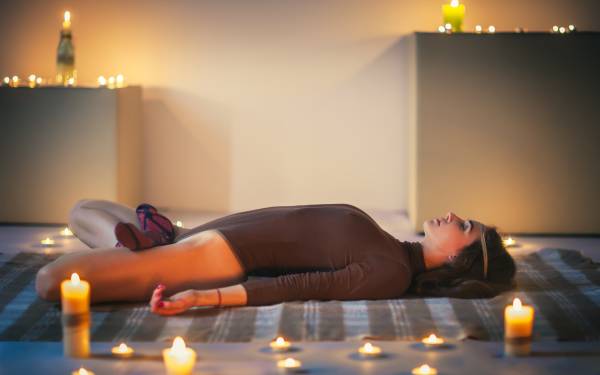
Dancer Pose And Yoga
Flexibility is a pillar for all dancers, as it gives dynamic ranges of motion, extended lines and allows for graceful movements as well. However, along with the pursuit of flexibility comes the risk of injuries that can cut a dancer's career short. To address this challenge, dancers have found solace in incorporating yoga into their training regimen. Yoga serves as a valuable tool for dancers, offering a holistic approach to improving their technique and preventing career-threatening injuries.
Yoga poses for dancers offer a twofold benefit: enhancing flexibility and strengthening the body to safeguard against potential injuries. By integrating yoga into their practice, dancers can cultivate a balanced approach that nurtures both the suppleness and strength necessary for their artistry.
Contraindications
Because of this pose requiring a very strong lower back, it is not advised for those suffering of slip disc to not practice it, because it puts a lot of pressure in the back. Same goes for those with carpal tunnel syndrome, as the wrists have to twist a lot.
The Role of Flexibility in Dance Movements
Flexibility is a fundamental aspect of dance, enabling dancers to achieve fluid and graceful movements, impressive extensions, and captivating lines. It allows for a greater range of motion and expression, enhancing the overall aesthetic and impact of a performance. Proper flexibility in specific areas of the body, such as the hips, knees, and hamstrings, is particularly crucial for executing various dance techniques and poses with precision and ease.
Pose 1: Pigeon Pose
This pose is of great importance for the health of people who spend many hours sitting and therefore end up with shortening in the psoas and decreasing the mobility of the external rotation of the hip, which can trigger false sciatica and an alteration in the curvature of the back.
To practice Pigeon Pose:
- Bend one leg and place it in front of the body, stretching the other leg backwards, so that the instep is resting on the mat.
- Place your hands on both sides of your body with the palms of your hands firmly resting on the floor.
- Little by little, stretch your arms and open your chest.
- There is also one more step, for more advanced levels. Once you achieve this pose, you can increase the level by bringing the bent back leg towards the buttock, holding the foot with the hand on the same side (repeat this movement with the opposite leg).
Pose 2: King Arthur Pose
These pose provides a very deep stretching of the hip flexors, quads, and psoas, which provides dancers with intense flexibility, allowing them to gain higher leg extensions (think of arabesque, for example) and deeper backbends as well.
To practice King Arthur Pose:
- From tadasana, bring the left foot back in a large step. The right heel should stay in line with the arch of the left foot, turned slightly outward at 45 degrees.
- Bend the right leg keeping the knee in line with the ankle, and the left leg fully straight, with the foot resting fully on the mat.
- Your body should face forward, with your shoulders and hips aligned in front of you.
- Inhale and raise your arms above your head, with your shoulders away from your ears, and look at your thumbs. You can bring your hands together or leave them shoulder-width apart.
- Lower your left knee so that it touches the mat, and raise your calf and stay for 5 breaths, deepening on each exhalation.
Strengthening for Injury Prevention
Countering Hyper-Mobility and Preventing Injuries through Strengthening
While flexibility is essential for dancers, it must be balanced with adequate strength to maintain stability and prevent injuries (with ankle or back injury being among the most common). Dancers who have hyper-mobile joints, particularly in the hips, knees, and spine, are more susceptible to painful injuries if the supporting muscles are weak or imbalanced.
Strengthening specific muscle groups can help counteract hyper-mobility, provide support to vulnerable areas, and promote overall body alignment and control.
Pose 1: Locust Pose
This pose which is goes by the name of Salabhasana as well, is a very relaxing lying backbend for beginners that helps strengthen the spine, especially the lumbar and dorsal area, while stretching the hip flexors, chest and abdominals. Strengthening these muscles is crucial for preventing injuries, particularly in dancers with hyper-mobile hamstrings.
To practice Locust Pose:
- We start lying face down, forehead supported, arms at the sides of the body, palms facing the floor, insteps resting on the mat and big toes together.
- Inhale and activate the buttocks to lift the head, chest, arms back and legs up.
- Leave the pelvis and abdominal area on the floor.
- Hold the posture for half a minute to a minute, rising a little higher on each inhalation.
Pose 2: Boat Pose
Navasana is an intense yoga posture that combines two types of work: abdominals and back, and on the other hand, balance. It is one of the asanas that is usually related to the work of core (the abdominal strip). But, beyond the physical image that we can get if we practice Navasana, this posture is important because it has a fundamental role in protecting the lumbar.
It is particularly beneficial for dancers who have hyper-mobile hips and spines, as strengthening the core muscles provides crucial support and stability.
To practice Boat Pose:
- To practice the boat pose, sit down and bend your knees so that the soles of your feet are on the yoga mat. Do not spread your feet and knees too far apart, they should be in line with your hips. Place your palms on the floor behind your back at the level of your buttocks to tilt your trunk backwards.
- As you breathe in, lift your feet up until your calves are parallel to the floor and also lift your hands off the floor. At first, you can support your legs by placing your hands under your bent knees. When you are stable on your buttocks, open your chest, relax your shoulders, look towards the horizon and separate your hands from your legs.
- Finally, exhale and stretch your arms forward so that they are parallel to the floor. Keep your chest open without curving your back.
Tips For Alignment
Establish a Strong Foundation
Ground your standing leg firmly without locking the knee. Activate the larger leg muscles - quadriceps, hamstrings, and calves - to protect the knee and enhance balance. Visualize lifting the kneecap of your standing leg to engage the upper leg muscles. Strengthening exercises such as Chair pose, Goddess pose, High Lunge, Warrior 2, Warrior 3, or Warrior 1 can also contribute to improved balance and stability.
Root Down Through Your Foot
Ensure all four corners of your standing foot are firmly grounded. Focus on lifting the natural arch of your foot, which aids in maintaining balance. This distributes the weight evenly throughout the feet, ankles, and surrounding leg muscles.
Align Your Hips
Resist the urge to rotate your body towards the side of the lifted back leg. This misalignment can disrupt your balance and potentially lead to lower back, knee, or hip discomfort. Instead, square your pelvis and hips towards the front short edge of your mat. This establishes a solid foundation and enhances stability on the standing leg.
Open Your Chest
During the forward lean and backbend of Dancer pose, prioritize opening and broadening your chest. Lift your chest upward and draw the shoulders away from the ears. This helps prevent compression of the spine and promotes proper alignment.
Engage the Lower Belly and Ribs
To maintain balance and prevent excessive forward tipping of the torso, engage your lower belly by drawing it inward. Additionally, knit the ribs together to support the midsection. This alignment cue enhances stability and control in the pose.
Cultivate a Gentle Backbend Shape
Strive for a soft "U" shape in your backbend rather than a sharp "V" shape. This approach protects the spine from compression. If you experience any discomfort or pinching, gently release from the pose. Stretching the surrounding areas, such as the abdomen and pelvis, can help deepen the backbend safely. Consider practicing preparatory poses like Camel pose, Bridge pose, Upward Salute with a slight backbend, or Wheel pose to increase flexibility in these regions.
Practice Patience and Mindfulness
Avoid getting caught up in the appearance of the pose or comparing yourself to others. Stay present and honor the limits of your own body. With patience and consistent practice, you will progress in your expression of the pose. Moving slowly and mindfully reduces the risk of knee, hip, and spinal injuries.


